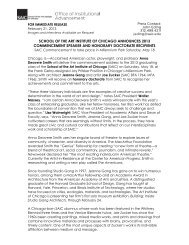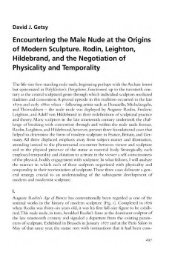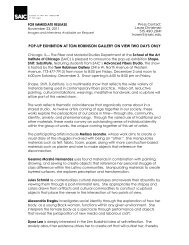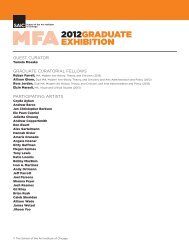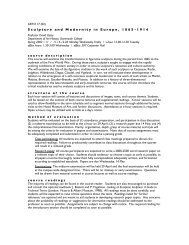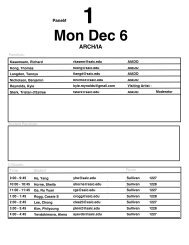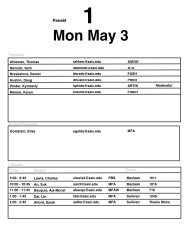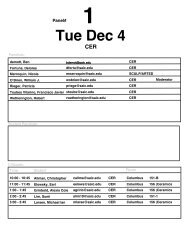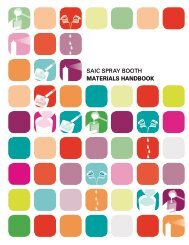i. institutional support and commitment to continuous improvement
i. institutional support and commitment to continuous improvement
i. institutional support and commitment to continuous improvement
You also want an ePaper? Increase the reach of your titles
YUMPU automatically turns print PDFs into web optimized ePapers that Google loves.
Course Number & Title:<br />
ARCH & INARC 5004 Design Visualization (3)<br />
Course Description:<br />
This first graduate studio course introduces incom-<br />
ing graduate students <strong>to</strong> basic 3D representation<br />
<strong>and</strong> fabrication for architecture <strong>and</strong> interior archi-<br />
tecture.<br />
Course Goals & Objectives:<br />
1) Design culture: introduction <strong>to</strong> design as a<br />
practice grounded in cultural <strong>and</strong> material in-<br />
novation.<br />
2) Design practice: introduction <strong>to</strong> graduate<br />
design studio as an inquiry-based pedagogy<br />
which depends upon rigorous experimentation<br />
with 3D representation <strong>and</strong> production.<br />
3) Design techniques: introduction <strong>to</strong> 3D com-<br />
puter drawing, modeling, <strong>and</strong> rendering, <strong>and</strong><br />
manufacturing techniques.<br />
Student Performance Criterion:<br />
1) Criteria<br />
a)A.6. Fundamental Design Skills<br />
Topical Outline:<br />
1) Students are introduced <strong>to</strong> design studio<br />
<strong>and</strong> descriptive media production through a<br />
computer application demos culminating in<br />
technical exercises <strong>and</strong> small, abstract design<br />
projects, no larger than 20’ x 20’ x 20’ in actual<br />
scale; desk crits <strong>and</strong> reviews associated with<br />
this work represent 50% of the course.<br />
2) Students are introduced <strong>to</strong> 3D digital model-<br />
ing <strong>and</strong> fabrication, including dimensional data<br />
entry, 2D <strong>to</strong> 3D modeling <strong>to</strong>ols, parametric<br />
modeling <strong>to</strong>ols, material indications, lighting<br />
techniques, rendering, plotting <strong>and</strong> 3D fabrica-<br />
tion using laser cutting <strong>and</strong> CNC techniques;<br />
assignments require that students develop<br />
their design project through these modeling<br />
techniques, producing a rendered digital model<br />
<strong>and</strong> digitally fabricated physical model of their<br />
design; 25% of the course.<br />
3) Students develop the ability <strong>to</strong> move across<br />
various production platforms, <strong>and</strong> complete<br />
assignments for their design project that<br />
include exporting <strong>and</strong> importing files from<br />
one program <strong>to</strong> another, developing manual<br />
pro<strong>to</strong>types for digitally fabricated models, <strong>and</strong><br />
manipulating digitally fabricated models with<br />
manual techniques; 25% of the course.<br />
Prerequisites:<br />
Admission <strong>to</strong> the MArch program.<br />
Textbooks/Learning Resources:<br />
Various text <strong>and</strong> online sources including:<br />
• http://www.rhino3d.com/<br />
• http://www.grasshopper3d.com/<br />
• Grasshopper Primer – 2nd Edition, by<br />
Andrew Payne<br />
• Generative Algorithms with Grasshopper<br />
by Zubin Khabazi<br />
Offered (semester <strong>and</strong> year):<br />
• Semester: SUMMER<br />
• Year: ONE<br />
Faculty assigned:<br />
• 2009-2010 academic year:<br />
Sterk, Tristan (F/T), Kasemsarn, Richard<br />
(P/T)<br />
• 2010-2011 academic year:<br />
Pancoast, Douglas (F/T), Sterk, Tristan<br />
(F/T)<br />
161 | Spring 2011<br />
IV. Supplemental Information<br />
Supplemental Information<br />
SECTION IV



